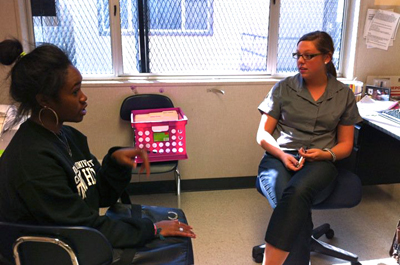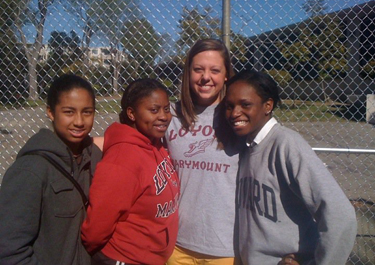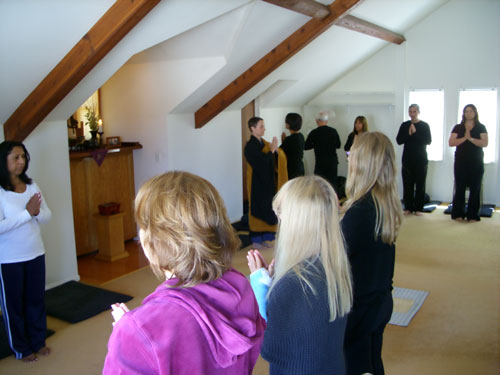 Classroom T-12 at Lou Dantzler Preparatory High School in Los Angeles is hidden within an urban maze of chain link fences, Port-o-Potties and portable classroom sheds called bungalows. But inside the makeshift-learning hub, a focused group of 12th grade English students works diligently on their research paper rough drafts, as the inspirational Michael Jackson song “Man in the Mirror” fills the room.
Classroom T-12 at Lou Dantzler Preparatory High School in Los Angeles is hidden within an urban maze of chain link fences, Port-o-Potties and portable classroom sheds called bungalows. But inside the makeshift-learning hub, a focused group of 12th grade English students works diligently on their research paper rough drafts, as the inspirational Michael Jackson song “Man in the Mirror” fills the room.
Their teacher’s white skin, pearl earrings and Kentucky twang immediately identify her as the outsider among a group of about two dozen African American students. Leaning over a cluster of desks, teacher Taylor Miller examines one of the rough drafts through her trendy eye-glasses before returning the paper to a male student nearly twice her size and uttering a sincere yet playful warning, “The beauty and eloquence of your writing needs to bring me to tears and then you’ll get your points back.”
Born and raised in a small suburb outside of Owensboro, Kentucky, 23-year-old Miller was expected to follow suit with her classmates and become the next generation of teachers and factory workers in their community.
“It’s a very small town mentality, people don’t really want you to leave, they don’t value world education, world culture and understanding,” explained Miller during her lunch break. “But I was just always itching to get out. I felt like people needed to see something and I knew there was something else out there.”
In her senior year at the University of Kentucky, Miller found out about the Teach for America program and its goal of closing the achievement gap in America’s failing public school system.
“I really just felt like I had some sort of calling to do that,” said Miller.
The program looks for the best and brightest college graduates in the country, gives them a crash course in teaching, and then places them in schools located in historically low income, minority communities for a two-year period. Each year the program only admits about 12 to 15 percent of the over 47,000 college graduates who apply, said Recruitment Director Tracy St. Dic.
Though applicants are given the opportunity to rank their preferences for assignment location, Miller decided to leave her destination up to fate.
“I thought that if I didn’t leave it to chance, I was going to go somewhere that’s comfortable. I wanted to go where I was needed,” said Miller whose parents were supportive but apprehensive of where she’d end up. “I think this was their biggest fear: L.A.”
Though Miller was prepared to go wherever she was needed, she admits that never in a million years had she considered the possibility of being sent to Los Angeles. She remembers just staring at her computer screen for about 30 minutes without speaking when she read her acceptance letter and placement location online.
“It was the unknown and people were like, a girl from rural Kentucky is never going to make it there. They’re not going to respect you, they’re not going to listen to you,” said Miller, who partly accepted the position in Los Angeles so she could change the minds of her community members. “A huge motivation was dispelling stereotypes that I grew up with about people of color and children of color, that people from my hometown I think still have.”
Several months later, she was on a plane bound for the other side of the country, and just days after, that she was in the classroom, teaching summer school. Teach For America’s training starts with what’s called the “summer institute,” where new corps members spend their mornings team-teaching summer school classes, and their afternoons in class themselves, soaking up new methods for teaching and classroom management.
“The institute will teach you everything you need to know to walk into the classroom on the first day, but nothing will prepare you for your first full day of teaching,” said Miller, as she recalled applying teaching methods in her summer school classroom just hours after learning them for the first time.
“It’s kind of traumatizing when it’s happening, but by the end of the summer, you have your own way of teaching and you’ve found what works for you and what doesn’t.”
With only a summer’s worth of experience and training, Miller got her first real class of ninth grade English students last year.
“The kids know a first-year teacher, they smell a first-year teacher and they have told me that they feel like it’s their responsibility to break in new teachers,” said Miller,
Miller said she was grateful to start with teaching ninth graders before moving up to the twelfth graders she teaches this year.
“They were easier to handle because it was their first year of high school too, and they were younger and still squirrelly, so I kind of had a little bit more authority.”
The “little bit of authority” she did have in her first year of teaching was often questioned when her students would ask her why she was so young, why she was white, why she had a southern accent and why she was their teacher.
“They couldn’t understand why I was harping on them so much and why I cared so much,” said Miller. “So I did this whole lesson on the achievement gap and where they fall on the scale and told them why we had to change this. It was like a complete turn around in their realization.”
Even when she was able to reach her students, there were days when that just didn’t seem like enough.
“I was an emotional wreck last year. It becomes this all-consuming, you have to save the world, it’s on your shoulders,” said Miller. “You have to learn that you can’t save everyone and not everybody needs to be saved. You have to just tell them what you know and give them an opportunity.”
More than a qualified teacher, Ms. Miller said her students just need a role model who believes in them. According to the Teach for America website, only half of students in low-income communities will graduate high school by age 18, and those who do graduate will perform on average at an eighth-grade level. With only one semester left in her two-year commitment to Teach For America, Ms. Miller’s goal is now to convince her AP English Language and Composition students that they are smart enough and capable enough to take the Advanced Placement test in May.
 “Right now, they see it as a demoralizing test that costs them money, and that they will get nothing out of,” said Miller. “That is the problem, this lack of confidence in what they can become and what they can achieve, and that is a battle I fight every day.”
“Right now, they see it as a demoralizing test that costs them money, and that they will get nothing out of,” said Miller. “That is the problem, this lack of confidence in what they can become and what they can achieve, and that is a battle I fight every day.”
According to her students, that fight doesn’t go unnoticed in her classroom.
“Ms. Miller is an excellent teacher, she influences you, she’s easy to talk to, and she doesn’t look down us,” said one of her twelfth grade students, Kayla Perry.
Student Jasmin Coleman added Ms. Miller has been a positive influence in her life not only as a teacher but as a friend and a mentor.
Similarly, twelfth grader Kenny Miller praised Ms. Miller as a wonderful teacher and one of the few who truly understands him.
While such praise would be gratifying enough, Miller is also looking to expand her impact on the Teach For America program in her last semester as a junior recruiter. Although she’s already recruited some of her friends from back home in Kentucky, she admits it hasn’t been easy to convince highly ambitious future leaders to spend two years in the classroom before starting their lives.
“A lot of people are like I don’t want to be a teacher, so I’m not going to do TFA,” said Miller. “But it’s not necessarily as much about the teaching as it is about the change and what can you do long-term.
“Being in the classroom for just two years, you learn so much from the ground level about the inequities these children face on a daily basis and then you spend the rest of your life working to correct it.
So in addition to whatever amazing thing you were already going to be, now you also have a passion for education that you’re going to carry with you for the rest of your life.”
Recruitment Director St. Dic said that while a third of their alums do choose to stay in the classroom after their two-year commitment, the goal of the program isn’t just to produce teachers, “We are looking to build life-long educational advocates.”
The remainder of the Teach For America alumni, including prominent advocates for education like Senator Michael Johnson and former Washington Chancellor Michelle Rhee, leave the classroom after their two years and go on to make sweeping changes in the educational system through careers in law, policy, business, medicine and journalism. In fact, the Teach for America website lists over 200 graduate and law schools who actively seek Teach For America alumni and offer special benefits to them, including two-year deferrals, application fee waivers, and scholarships.
As for Miller, she sees herself staying on the Teach for America staff next year to help cultivate the next batch of corps members, and eventually becoming a writer of some sort. She acknowledges that no matter what she does in her future, Teach For America has changed her in ways she could have never foreseen as a college graduate back in Kentucky.
“I’m a completely different human now, just my thoughts about the world and what is really wrong and whose fault it is,” said Miller. “There is nothing I could have done at 22 or 23 years old right out of college that would have been more meaningful, powerful or impactful.”










 “We’re always in motion like a jar of mud and water. When you sit the jar down, the mud settles and the water becomes crystal clear. The same is true of our minds,” said Stevens, who goes by his Dharma name of Doman.
“We’re always in motion like a jar of mud and water. When you sit the jar down, the mud settles and the water becomes crystal clear. The same is true of our minds,” said Stevens, who goes by his Dharma name of Doman.




